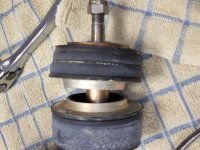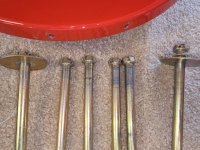Dear A Team,
The engine on my 6A is out for IRAN and depending on how bad the backlog for parts at Lycoming is (I've been warned it's bad) I may get it back someday. In the meantime, I am cleaning up everything on the firewall, Flushing oil lines, New cable end caps, Aviation grade clamps and zip ties, Etc..
Wondering if I should replace the upper engine mounting biscuits (Not to apparent in the pic but one side looks like it has taken a set from 16 years for weight) and the prop hardware. The galling looks mild compared to some of the videos on YouTube but I figure these should be replaced during any prop removal anyways. Is it normal to just trash the bolts and replace with new?
Thanks,
Kirk
The engine on my 6A is out for IRAN and depending on how bad the backlog for parts at Lycoming is (I've been warned it's bad) I may get it back someday. In the meantime, I am cleaning up everything on the firewall, Flushing oil lines, New cable end caps, Aviation grade clamps and zip ties, Etc..
Wondering if I should replace the upper engine mounting biscuits (Not to apparent in the pic but one side looks like it has taken a set from 16 years for weight) and the prop hardware. The galling looks mild compared to some of the videos on YouTube but I figure these should be replaced during any prop removal anyways. Is it normal to just trash the bolts and replace with new?
Thanks,
Kirk






